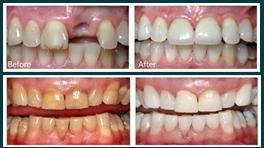A bacterial infection of the gums and tissues that support your teeth is known as Gum disease or periodontal disease. When teeth are not routinely cleaned properly it leads to the build-up of plaque and tartar resulting in gum disease.
The two stages of periodontal disease are periodontitis and gingivitis. Gingivitis is a mild form of gum disease that affects only the gums. It may be reversed if properly treated. Gingivitis turns into periodontitis if left untreated. Bacteria penetrate into the deeper pockets of tissue during this more destructive disease stage, attacking the bone and membrane that support your teeth. Periodontitis can lead to serious health problems and tooth loss.
Risk factors
You may be at risk of gum disease if any of the following apply to you:
• Systematic diseases
• Tobacco and alcohol use
• Pregnancy
• Genetics
• Prescription drugs (steroids, oral contraceptives, cancer therapy drugs, etc)
Warning signs
Pain does not always occur as warning signs hence gum disease is considered a “silent” disease. If you experience the below mentioned symptoms see your dentist immediately:
• Gums that bleed while brushing teeth
• Gums that are receding from your teeth
• Changes to your gums
• Odd taste in your mouth
• Persistent bad breath
• Changes to your bite, teeth or dental work
• Partial dentures or bridges that no longer fit properly
• Recurring puffiness, redness, tenderness or swelling of your gums
• Constant metal taste in your mouth
• Pus between your teeth and gums
How do we treat gum disease?
It depends on the stage of your infection and the amount of deterioration involving your teeth, gums, bone and supporting tissues.
Your dentist will discuss your treatment after reviewing your Digital X-rays and performing a thorough periodontal exam.
Non-Surgical Treatment
Scaling and root planning are the most well-known type of non-surgical treatment. A careful removal of tarter and plaque from the tooth roots is done in this under-the-gum procedure. Your dentist will get rid of destructive bacteria from deep beneath your gums during this procedure, to prevent plaque build-up again.
Surgical Treatment
To regenerate lost bone or to eliminate bone infections your dentist may execute periodontal surgery. The most common surgical treatments are:
Pocket Reduction
A local anaesthetic is applied during this procedure. To expose hidden areas of bacteria irregular surfaces of the damaged bone may need to be smoothed. Gum tissue is then closed and sutured in place.
Bone Regeneration
A local anaesthetic is applied during this procedure. To expose deeper tissues gum tissue is folded back and bacteria that are causing the disease removed. To encourage your body’s natural ability to reverse some of the damage of gum disease and encourage bone regeneration bone grafts, membranes, or proteins that stimulate tissue are used.


